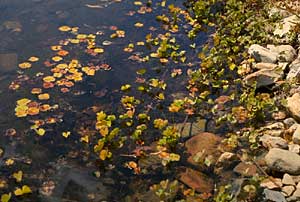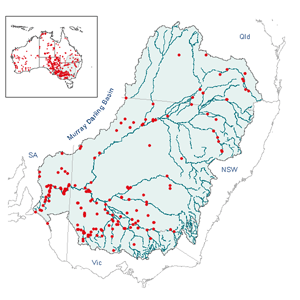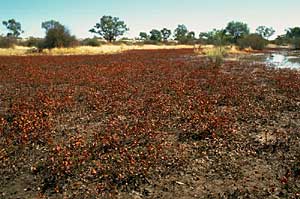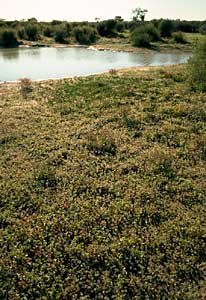Taxon Attribute Profiles

Fronds floating on water surface.
|
Marsilea drummondii A.Braun
Common Nardoo
Introduction
Marsilea drummondii is a common and widespread fern of wetland
areas across inland Australia. It grows from a creeping rhizome, reproducing
from sporocarps, and can form dense swards following flooding so that
it is the dominant component of the groundcover layer.
Taxonomy and Ecology
Classification
Family: Marsileaceae
Genus: Marsilea - approximately 65 species worldwide; c.
6 species in Australia.
Notes: For a recent taxonomic description of Marsilea drummondii
see Jones (1988).

Upright fronds, slightly hairy, with sporocarps on short stems at
their base.
|
Life form
Marsilea drummondii is an aquatic perennial rhizomatous fern.
It is highly polymorphic in many features. The sterile fronds are erect
when growing in mud, floating when growing in water (Jones, 1998), each
consisting of two pairs of leaflets arranged in a fourleaf-clover pattern.
The flexible stems allow the plants to adapt to small changes in water
level (although M. drummondii has been seen in water up to 1 m
deep), while keeping their leaves on the water surface to access light
and carbon dioxide (Roberts and Marston, 2000).

Floating (left) and emerging with upright fronds (right) on the edge
of a pool. |

click to enlarge map
|
Distribution
Marsilea drummondii is endemic to inland areas of Australia (Jones,
1998), occurring in all states and territories except Tasmania and the
Australian Capital Territory.
Habitat
Marsilea drummondii grows in shallow, still or sluggishly flowing
water, in seasonally wet habitats (Jones, 1998) such as on the margins
of gilgais, waterholes, claypans, swamps, rivers and their floodplains,
roadside table-drains and depressions in many vegetation communities (Cunningham
et al., 1981). It has also been observed in flowing floodwaters
to 1 metre deep (Roberts and Marston, 2000), and commonly persists in
drying mud (pers. comm., D.L. Jones, 2004) and marshy sites. Marsilea
drummondii has been recorded on a number of different soil types,
ranging from sands to clays (Australian National Herbarium, Canberra,
2004).

Marsilea turns brown and forms sporocarps as the floodwaters
receed. Coongie Lakes, NW Sth Aust. |

From the air, receeding floodwaters expose large areas of browning
Marsilea (foreground) at Coongie Lakes. |

While the ground is still damp Marsilea forms a green carpet
(foreground) with lignum behind. Coongie Lakes. |
"Status" in community
Marsilea drummondii is frequently the dominant species in the
herbaceous zone, especially on mudflats during and after flooding (Cunningham
et al., 1981).
Associated species
No species are recorded as particular associates for M. drummondii
given its wide ecological latitude and occurrence in a variety of vegetation
communities. Associated species and vegetation communities recorded on
specimen labels in the Australian National Herbarium include Eucalyptus
camaldulensis open forest (with Acacia stenophylla
and Muehlenbeckia florulenta), Eucalyptus largiflorens
association, Juncus spp., Myriocephalum rhizocephalus,
mixed herb-sedgeland, Triglochin sp. Typha domingensis and
T. orientalis.
Qualitative and quantitative data – abundance, cover, biomass
No specific data is available relating to cover, abundance or biomass.
However, as noted above, M. drummondii can be the dominant ground
cover following flooding with receding waters, in some cases reaching
100% cover.
Species – interactions with other biodiversity
The sporocarps are eaten by waterfowl (Jones, 1998).
Physiological traits & adaptations
Marsilea drummondii is well adapted to arid and semi-arid environments
and is able to respond to changing water levels. Spore production and
germination can be triggered by variations in moisture. Plants survive
well on damp mud, but with the desiccation of the soil, the leaves shrivel
and the sporocarps become detached and dry, some lodging in the cracks
of the drying mud where they can remain viable for 20-30 years. When substantial
inundation again occurs, the sporocarps open and new plants are eventually
produced (Aston, 1973).
Under certain seasonal conditions M. drummondii contains extremely
high levels of thiaminase I activity. This can induce a thiamine deficiency
in sheep feeding on the species (McCleary and Chick, 1977). The nardoo
diet of members of the Burke and Wills expedition (1860-1861) exacerbated
their decline in health due to high levels of the enzyme Thiaminase (Jones,
1998).
Reproduction and Establishment
Reproduction
Fruiting is rare in water but occurs on drying mud as the water recedes.
Spores are contained in solitary or clustered hard sporocarps on unbranched
stalks 10-50 mm long. Sporocarps only split after substantial immersion
in water. Some sporocarps remain hard and closed for many years (up to
50) and do not open even after several floods (pers. comm., D.L. Jones,
2004). Sporocarps have been recorded from November to March (Aston, 1973;
Jones, 1998; pers. comm., D.L. Jones, 2004).
Dispersability; establishment and growth
Sporocarps are probably dispersed by waterfowl since they pass undamaged
through their digestive tract (Jones, 1998). Dispersal also occurs by
floodwaters and probably by wind (pers. comm., D.L. Jones, 2004). When
flooding occurs the sporocarps release their spores, leading to the establishment
of new plants (Cunningham et al., 1981). Marsilea drummondii
grows throughout the year, provided moisture conditions are favourable
(Cunningham et al., 1981).
Juvenile period
Plants grow rapidly and can form sporocarps within three months (Cunningham
et al., 1981).
Hydrology and salinity
Hydrology
The distribution of Marsilea drummondii is intimately linked with
the flooding regimes of inland Australia.
Salinity tolerance
A salinity range of 0.2 – 0.3 ppt T.D.S. has been recorded for M.
drummondii (Yezdani, 1970 in Aston, 1973).
Flooding regimes
In northern Victoria, M. drummondii has been found where flooding
occurs in spring-summer, lasts one to six months, and is shallow (less
than 10 cm deep) (Ward, 1996 in Roberts and Ludwig, 2000).
Change in water regimes
Short term floods result in little germination. Those plants that do
germinate die without establishing or reproducing (pers. comm., D.L. Jones,
2004).
Response to disturbance (non-hydrological)
Grazing
Marsilea drummondii is usually eaten sparingly and survives grazing
well (Cunningham et al., 1981).
Conservation status
This species is widespread in inland Australia and is not considered
to be at risk.
Uses (including ethnobotanical)
Nardoo is a food plant for aboriginal people, who gather the sporocarps,
grind them, and mix the powder with water (Aston, 1973) to form an edible
dough (Cunningham et al., 1981). It is regarded by some as a useful
forage plant but it is probably very low grade fodder. It is generally
not favoured by stock when alternative feed is available. It is claimed
to cause poisoning in sheep, horses and cattle. However, ingestion does
not always result in poisoning (Cunningham et al., 1981).
Marsilea drummondii is a popular horticulture subject and is widely
cultivated as a garden pond plant.
Summary
Marsilea drummondii is a common and widespread component of the
herbaceous layer of wetland communities in inland Australia. Its lifecycle
is closely tied to changes in water regimes, and reproduction and germination
is almost completely dependent on cycles of flooding and drying. It has
a low salinity tolerance and is potentially a species that may provide
useful indication of health of mudflats as well as being a suitable plant
for monitoring purposes. It plays an important part in the diet of aboriginal
people in the semi-arid and arid parts of Australia.
References
Aston, H.I. (1973) Aquatic plants of Australia: a guide to the identification
of the aquatic ferns and flowering plants of Australia, both native and
naturalized, pp. 37-39. Melbourne University Press, Carlton.
Australian National Herbarium, Canberra. (2004). Australian National
Herbarium Specimen Information Register. Available at: http://www.anbg.gov.au/cgi-bin/anhsir
[Accessed: 2004, June].
Cunningham, G.M., Mulham, W.E., Milthorpe, P.E. and Leigh, J.H. (1981)
Plants of Western New South Wales, p. 32. Soil Conservation Service of
New South Wales.
Jones, D.L. (1998) Marsileaceae. In Flora of Australia, Volume 48, Ferns,
Gymnosperms and Allied Groups, pp.166-173. ABRS/CSIRO Australia.
McCleary, B.V. and Chick, B.F. (1977) The purification and properties
of Thiaminase I enzyme from Nardoo (Marsilea drummondii). Phytochemistry
16, 207-213.
Roberts, J. and Marston, F. (2000) Water Regime of Wetland and Floodplain
Plants in the Murray-Darling Basin: A Source Book of Ecological Knowledge.
CSIRO Land and Water, Technical Report 30-00
Wakefield, N.A. (1955) Ferns of Victoria and Tasmania: with descriptive
notes and illustrations of the 116 native species, p. 56. Field Naturalists
Club of Victoria, Melbourne.
|

